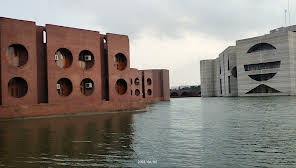Islam was brought to Bangladesh by the Arab traders who arrived in the region in the 8th century. Bangladesh, a South Asian country known for its rich cultural heritage and diverse history, was introduced to the Islamic faith by Arab traders who traversed the region during the 8th century.
The arrival of Islam in Bangladesh not only transformed the religious landscape but also left an indelible mark on the country’s social structure, architecture, and traditions. Over the centuries, Islam has become an integral part of Bangladeshi identity, influencing various aspects of life including art, education, and governance.
This historical integration of Islam into Bangladeshi society has shaped the country’s unique cultural mosaic, reflecting the harmonious coexistence of different religious beliefs and traditions.

Credit: bnn.network
The Spread Of Islam In Bangladesh
Early History
Bangladesh has a rich history of Islamic influence dating back to the 7th century. It is believed that the Arab traders and merchants first brought Islam to the region. The conquest of Sindh by the Arab general Muhammad bin Qasim in 711 AD played a crucial role in introducing Islam to the Indian subcontinent, including present-day Bangladesh.
Influence Of Sufi Saints
The spread of Islam in Bangladesh was further facilitated by the influence of Sufi saints. These spiritual leaders played a significant role in disseminating the teachings of Islam and attracting followers through their message of universal love, peace, and brotherhood. Their emphasis on spirituality and personal experiences of the divine resonated with the masses, contributing to the widespread acceptance of Islam in the region.
Prominent Islamic Figures
Islam in Bangladesh was introduced by prominent Islamic figures, such as Shah Jalal and Khan Jahan Ali. They played pivotal roles in spreading the religion and establishing Islamic heritage in the region.
The history of Islam in Bangladesh is intertwined with the lives of several Prominent Islamic Figures who played a crucial role in spreading the religion in the region. These individuals were instrumental in not only bringing Islam to Bangladesh but also in establishing Islamic traditions and values that have shaped the country’s culture and society. Among the most revered figures are Hazrat Shah Jalal and Khan Jahan Ali, whose contributions continue to be celebrated to this day. Hazrat Shah Jalal, a renowned Sufi saint, is widely regarded as one of the key figures responsible for bringing Islam to Bangladesh. Born in Yemen, he arrived in Sylhet in the 14th century and began his mission of spreading the teachings of Islam. With his charismatic personality and profound knowledge of the religion, Hazrat Shah Jalal attracted a large number of followers, who embraced Islam under his guidance. His spiritual teachings and humanitarian efforts significantly influenced the religious landscape of Bangladesh. Khan Jahan Ali, another notable Islamic figure, played a pivotal role in the establishment of Islam in the southwestern region of Bangladesh. He is best known for his contribution to the development of Bagerhat, a UNESCO World Heritage Site that houses several magnificent mosques and mausoleums. Khan Jahan Ali’s most renowned architectural feat is the Sixty Dome Mosque, a testament to his devotion and architectural genius. His efforts in promoting Islamic values and principles greatly influenced the region and continue to inspire generations of Muslims. These Prominent Islamic Figures not only brought Islam to Bangladesh but also contributed to the socio-cultural fabric of the nation. Their teachings and actions continue to resonate with the Muslim community, serving as a source of inspiration and guidance. Today, Bangladesh is a predominantly Muslim country where the principles of Islam shape the lives of its people. The legacies of Hazrat Shah Jalal and Khan Jahan Ali live on, reminding us of the significant role they played in the history and development of Islam in Bangladesh.Impact On Bangladeshi Culture
Islam has had a profound impact on Bangladeshi culture since its arrival in the region. The religion brought along with it a rich and diverse set of customs, traditions, and artistic expressions that have shaped the cultural landscape of Bangladesh. From language and literature to architecture and art, the influence of Islam can be seen in various aspects of Bangladeshi society.
Language And Literature
The introduction of Islam in Bangladesh led to the adoption of Arabic as a sacred language for Muslims in the region. While Bengali remained the primary language of the masses, Arabic became significant for religious purposes. This linguistic influence is evident in the presence of numerous Arabic loanwords in the Bengali vocabulary, particularly in religious and spiritual contexts.
Additionally, Islamic literature, including the Quran and various Islamic texts, has greatly influenced Bengali literature. Islamic teachings and stories have been incorporated into Bengali literature, adding spiritual and moral dimensions to literary works. This fusion of Islamic and Bengali literary traditions has contributed to the richness and diversity of Bengali literature.
Architecture And Art
The impact of Islam on Bangladeshi culture can also be observed in its architectural and artistic expressions. Islamic architecture, characterized by intricate geometric patterns, domes, and minarets, has become a prominent feature in many mosques and historical buildings throughout Bangladesh. These architectural marvels not only serve as places of worship but also as architectural masterpieces that showcase the rich Islamic heritage in the region.
Islamic art, with its emphasis on calligraphy and geometric patterns, has also influenced Bangladeshi art. Intricate calligraphy, depicting Quranic verses and Islamic symbols, can be found in various forms of Islamic art, including paintings, textiles, and pottery. The incorporation of Islamic artistic elements into Bangladeshi art has resulted in a unique blend of cultural expressions that reflects the strong influence of Islam.

Credit: www.researchgate.net
Credit: en.wikipedia.org
Frequently Asked Questions On Who Brought Islam To Bangladesh?
Who Brought Islam To Bangladesh?
The answer to this question requires a contextual understanding of the history of Bangladesh. Islam was brought to Bangladesh by various Arab traders, Sufi missionaries, and Muslim rulers who had influence in the region. The spread of Islam in Bangladesh was a gradual process that spanned over several centuries.
However, specific individuals who played key roles in the propagation of Islam in Bangladesh cannot be attributed to a single person.
Conclusion
The arrival of Islam in Bangladesh can be traced back to the 13th century with the influence of various Sufi saints and the activities of traders and missionaries. This rich history of Islamic heritage has shaped the cultural and religious landscape of the country.
Today, Islam is one of the major religions in Bangladesh, playing a significant role in the lives of millions of people. Understanding the origins and spread of Islam in Bangladesh allows us to appreciate the multifaceted nature of the country’s religious traditions.



